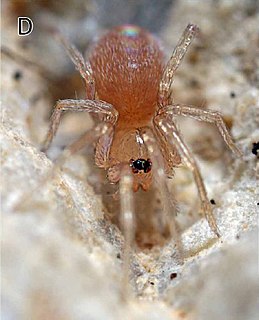
Oonopidae, also known as goblin spiders, is a family of spiders consisting of over 1,600 described species in about 113 genera worldwide, with total species diversity estimated at 2000 to 2500 species. The type genus of the family is OonopsKeyserling, 1835.

The caddisflies, or order Trichoptera, are a group of insects with aquatic larvae and terrestrial adults. There are approximately 14,500 described species, most of which can be divided into the suborders Integripalpia and Annulipalpia on the basis of the adult mouthparts. Integripalpian larvae construct a portable casing to protect themselves as they move around looking for food, while Annulipalpian larvae make themselves a fixed retreat in which they remain, waiting for food to come to them. The affinities of the small third suborder Spicipalpia are unclear, and molecular analysis suggests it may not be monophyletic. Also called sedge-flies or rail-flies, the adults are small moth-like insects with two pairs of hairy membranous wings. They are closely related to the Lepidoptera which have scales on their wings; the two orders together form the superorder Amphiesmenoptera.

Psychodidae, called drain flies, sink flies, filter flies, sewer flies, or sewer gnats, is a family of true flies. Some genera have short, hairy bodies and wings giving them a "furry" moth-like appearance, hence one of their common names, moth flies. Members of the sub-family Phlebotominae which are hematophagous may be called sand flies in some countries, although this term is also used for other unrelated flies.
Frank Morton Carpenter received his PhD from Harvard University, and was curator of fossil insects at the Harvard Museum of Comparative Zoology for 60 years. He studied the Permian fossil insects of Elmo, Kansas, and compared the North American fossil insect fauna with Paleozoic taxa known from elsewhere in the world. A careful and methodical worker, he used venation and mouthparts to determine the relationships of fossil taxa, and was author of the Treatise volume on Insects. He reduced the number of extinct insect orders then described from about fifty to nine.

Tetrablemmidae, sometimes called armored spiders, is a family of tropical araneomorph spiders first described by Octavius Pickard-Cambridge in 1873. It contains 126 described species in 29 genera from southeast Asia, with a few that occur in Africa and Central and South America. Pacullidae was incorporated into this family in 1981, but was later restored as a separate family in a 2016 phylogenetic study.
David A. Grimaldi is an entomologist and Curator of Invertebrate Zoology at the American Museum of Natural History in New York. He received his graduate training at Cornell University, where he earned his doctorate in Entomology in 1986. Dr. Grimaldi is an authority in many fields of insect systematics, paleontology, and evolutionary biology.
Agathiphaga is a genus of moths, known as kauri moths. It is the only living in the family Agathiphagidae. This caddisfly-like lineage of primitive moths was first reported by Lionel Jack Dumbleton in 1952, as a new genus of Micropterigidae.

The Ecnomidae are a family of caddisflies comprising 9 genera with a total of 375 species.
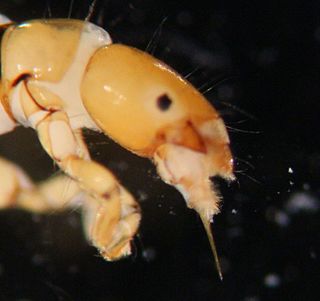
Dipseudopsidae is a family of caddisflies in the order Trichoptera. There are about 6 genera and at least 110 described species in Dipseudopsidae.
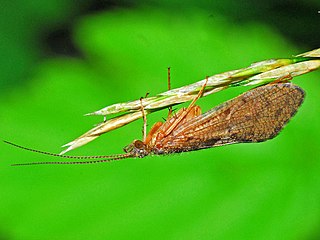
Rhyacophila is a genus of caddisflies in the family Rhyacophilidae. There are at least 640 described species in Rhyacophila.
Culoptila is a genus of caddisflies found primarily in Central America as well as the United States.
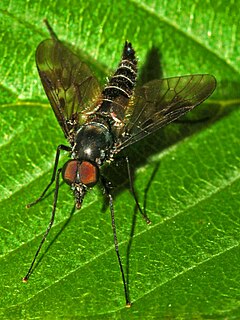
Athericidae is a small family of flies known as water snipe flies or ibis flies. They used to be placed in the family Rhagionidae, but were removed by Stuckenberg in 1973. They are now known to be more closely related to Tabanidae. Species of Athericidae are found worldwide.

Archaeomarasmius is an extinct genus of gilled fungus in the Agaricales family Tricholomataceae, containing the single species Archaeomarasmius leggetti. It is known from two fruit bodies recovered from amber, one consisting of a complete cap with a broken stem, the other consisting of a fragment of a cap. The cap has a diameter ranging from 3.2 to 6 mm, while the stem is 0.5 mm (0.02 in) thick. Spores were also recovered from the amber, and are broadly ellipsoid to egg-shaped, measuring roughly 7.3 by 4.7 μm. The species, which resembles the extant genera Marasmius and Marasmiellus, is inferred to have been saprobic on plant litter or other forest debris.
Palerasnitsynus is a genus of extinct caddisfly that existed during the Late Albian Cretaceous of Myanmar. It is known from two specimens trapped in amber; one of these is of the type species Palerasnitsynus ohlhoffi, and the species of the second has not been identified.
Dysoneuridae is an extinct family of insect in the order Trichoptera, the caddisflies. The family was first described by I.D. Sukacheva in 1968, and lived in the Mesozoic era between 164.7 mya to 125.45 mya. Members of this family lived in lagoons, ponds, and terrestrial habitats.

Mexican amber, also known as Chiapas Amber is amber found in Mexico, created during the late Oligocene and Early Miocene epochs of the Cenozoic Era in southwestern North America. As with other ambers, a wide variety of taxa have been found as inclusions including insects and other arthropods, as well as plant fragments and epiphyllous fungi.
Georg Ulmer was a German entomologist who specialized in research of Trichoptera (caddisflies) and Ephemeroptera (mayflies).
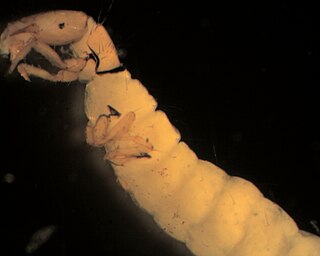
Wormaldia is a genus of fingernet caddisflies in the family Philopotamidae. There are more than 140 described species in Wormaldia. Fossil species have been described from the Late Cretaceous Burmese amber of Myanmar.

Phylocentropus is a genus of caddisflies in the family Dipseudopsidae. There are about 17 described species in Phylocentropus.
Cretapsyche is an extinct genus of caddisflies in the extinct family Dysoneuridae. It is from the Late Cretaceous (Cenomanian) and specimens are from Burmese amber.










